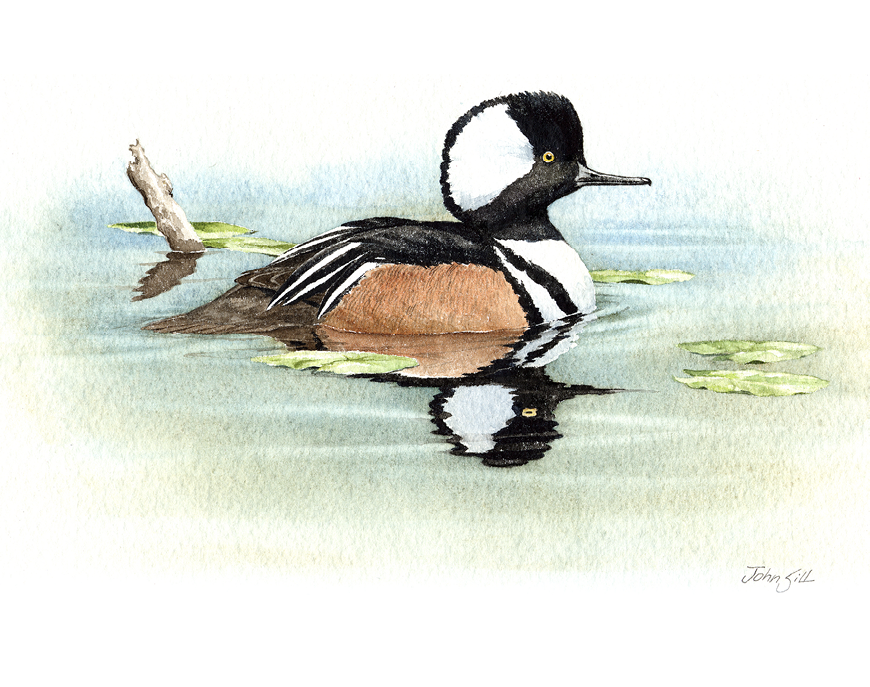Hooded Merganser by John Sill

Hooded Merganser by John Sill © Massachusetts Audubon Society. Courtesy of the Museum of American Bird Art.
About the Cover Artist
John Sill is a freelance wildlife artist living in the mountains of North Carolina. He was the illustrator for the Bird Identification Calendar for Mass Audubon for many years. His work has appeared in Birds In Art at the Leigh-Yawkey Woodson Art Museum, Wausau, Wisconsin, and in Art of the Animal Kingdom at the Bennington Center for the Arts in Vermont. He continues to illustrate the "About" and "About Habitats" series of natural history books for children written by his wife Cathryn.
Hooded Merganser
The Hooded Merganser (Lophodytes cucullatus) is the smallest, and arguably the most beautiful, of the North American mergansers and the only one endemic to North America. Because of its secretive nature and widely dispersed population, its biology is poorly known. Males are identified by their small size; their black face, neck, and back; orangey-brown flanks; and a white fan-shaped crest that is edged in black. The crest appears as a white line extending back from the eye when it is depressed. The bill is long and narrow. The female's small size, brownish crest, and dark bill with a yellowish lower mandible separate it from other mergansers. Juveniles resemble females but the crest is not as prominent and the bill is dark. There is little geographic variation among Hooded Mergansers and there are no subspecies recognized. Originally described as belonging to the genus Mergus together with the other North American mergansers, in 1983 it was split off into its current genus because certain behavioral and skeletal features suggested that it was intermediary between the Mergus species and the goldeneyes of the genus Bucephala. Currently, the proper genus for Hooded Mergansers is still under debate.
The breeding range of migratory Hooded Mergansers extends from south-central Canada east to Nova Scotia and south across the northern Great Lakes, dipping into the central United States west to North Dakota and south to Missouri. Migratory birds winter in the Northwest from northern British Columbia south to Washington and California. They winter from Kansas through Texas and also in the Southeast along the Gulf Coast and into Florida. Some birds also winter in Arizona and scattered across the Rocky Mountain states. In the Pacific Northwest, year-round residents breed from British Columbia south to northern California and eastern Montana. Year-round populations in the eastern United States breed almost as far south as the Gulf Coast from Texas to north Florida. In Massachusetts, the Hooded Merganser is considered an uncommon and local breeder. It is a fairly common and increasingly numerous migrant, with the largest numbers occurring in the fall, and leaving before the lakes and ponds freeze over. They also regularly winter in increasing numbers, especially on Cape Cod and the Islands.
Hooded Mergansers are seasonally monogamous, but the timing of pair formation is not totally clear. They first breed at age two and produce a single brood per season. Females tend to be faithful to a breeding site. Hooded Mergansers are usually silent but both sexes may make frog-like noises during courtship, especially in late fall and early winter. Courtship displays often involve several males and a single female. Male displays—which always involve an erected crest—include head-shaking, a head throw in which the male tosses his head back until it touches his back, head pumping in which the head is extended upward and the bill rotated, a ritualized drinking display with head pointed upwards, and an upward stretch with head shaking and wing-flapping. Females bob their heads with the bill pointed downwards, and head pump.
Hooded Mergansers nest in a wide range of forested wetlands, including beaver ponds, emergent marshes, rivers, creeks, ponds, and swamps. They tend to avoid deep water lake shores. The nest is usually in a natural cavity in a living or a dead tree, near or over water, or even in a nest box. The female selects the nest site and no materials are added to the cavity except for a lining of down. Only the female has a brood patch and she alone incubates the up to a dozen white, near spherical, and thick-shelled eggs for about a month until hatching. The male deserts the female once incubation begins. There is considerable nest parasitism among Hooded Mergansers, Wood Ducks, and Common Goldeneyes, each often laying eggs in the others' nests. Hooded Mergansers may even lay eggs in the nests of other pairs of their own species as well. If the nest appears threatened, the female may drop to the water and give a broken-wing distraction display. The precocial chicks leave the nest within a day after hatching when the female calls to them from the water below. They drop from the nest, join the female, and can forage almost immediately on their own, primarily for invertebrates. Little is known about the growth, development, or survival rate of the chicks.
Hooded Mergansers forage on a broad range of food types, which is uncharacteristic of other merganser species. Their main prey is fish, but they also take substantial numbers of crustaceans and insects, along with a few amphibians, mollusks, and vegetation. Their serrated bill is used for grasping prey. As shallow water specialists, they tend to be visual foragers.
During nesting, Hooded Mergansers are preyed upon by raccoons, snakes, and the usual spectrum of avian predators. Hunters take an estimated quarter of the population each year. Habitat alteration, especially the destruction of cavity-bearing trees, doubtless has had a negative effect on their population. The effects of acid rain in their breeding areas are unknown but suspect. The population of this enigmatic species is not accurately known; however, numbers in Massachusetts are definitely increasing even if overall population trends are unknown. Hunting harvest data suggests that the population is stable and possibly even increasing, so perhaps there is hope for this lovely little merganser species.
William E. Davis, Jr.